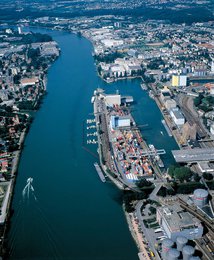Cross-border economic development
Contributing to the competitiveness of the territory
It is also important to incorporate the cross-border approach into a long-term territorial plan. Economic development measures are implemented in organised spaces. However, only a bi-or tri-national concerted vision and a real project allow the organisation of cross-border areas. In other words, approaches to spatial planning must also promote the objective of economic development.
The attractiveness of border territories will depend mainly on the quality of major infrastructure (large university facilities, hospitals, transport infrastructure, broadband availability, etc.), as well as that of public services, and services to businesses.
For the realisation of this type of infrastructure, the strategic guidance documents used (which are often transposed into planning schemes) become all the more important, because in a cross-border context this involves the coordination and pooling of existing or planned facilities.
The concept of competitiveness also refers to a new dimension, specifically, the workforce’s capacity for adaptation (through training, etc.).
Economic sectors in need of particular attention in a cross-border context include the logistics sector (infrastructure, services, networking of platforms...), the tourism sector, etc.
In order to optimise the implementation of such large facilities (airport, etc.) in a cross-border context for the benefit of all, a common vision is required. This is more difficult to achieve than in a purely domestic context, requiring strong political backing and a long-term vision.
For harmonious and effective cooperation, the need for a common agenda between the private and public sectors must be taken into account (e.g. in terms of the timing of implementation of public policies, calls for project proposals for the European funds etc.).
Branding and joint territorial marketing of the cross-border area add to the attractiveness of the territory. Joint promotion of the cross-border economic space, for example through local initiatives (media, etc.), and international promotion of products, services and expertise can generate substantial added value.


